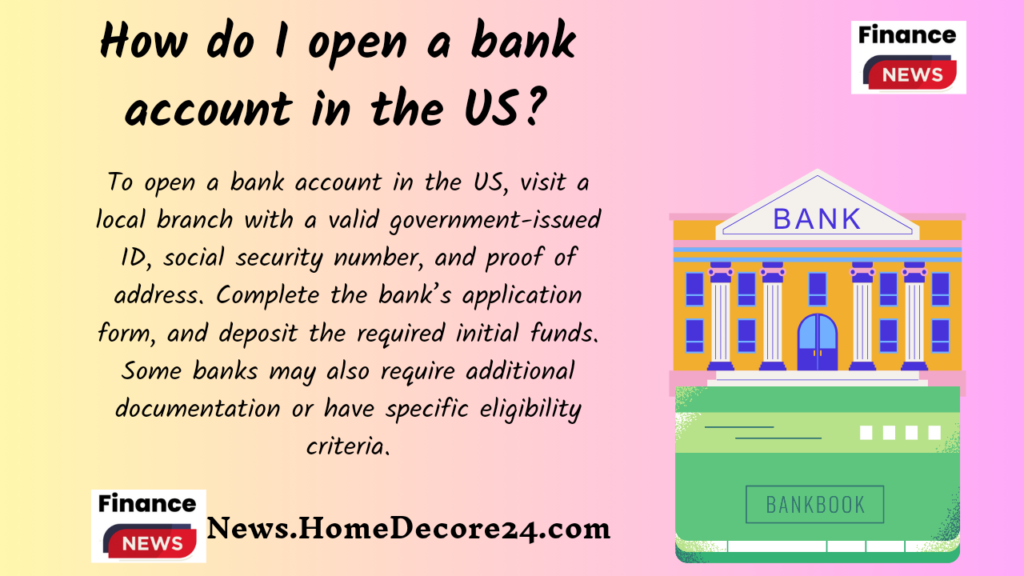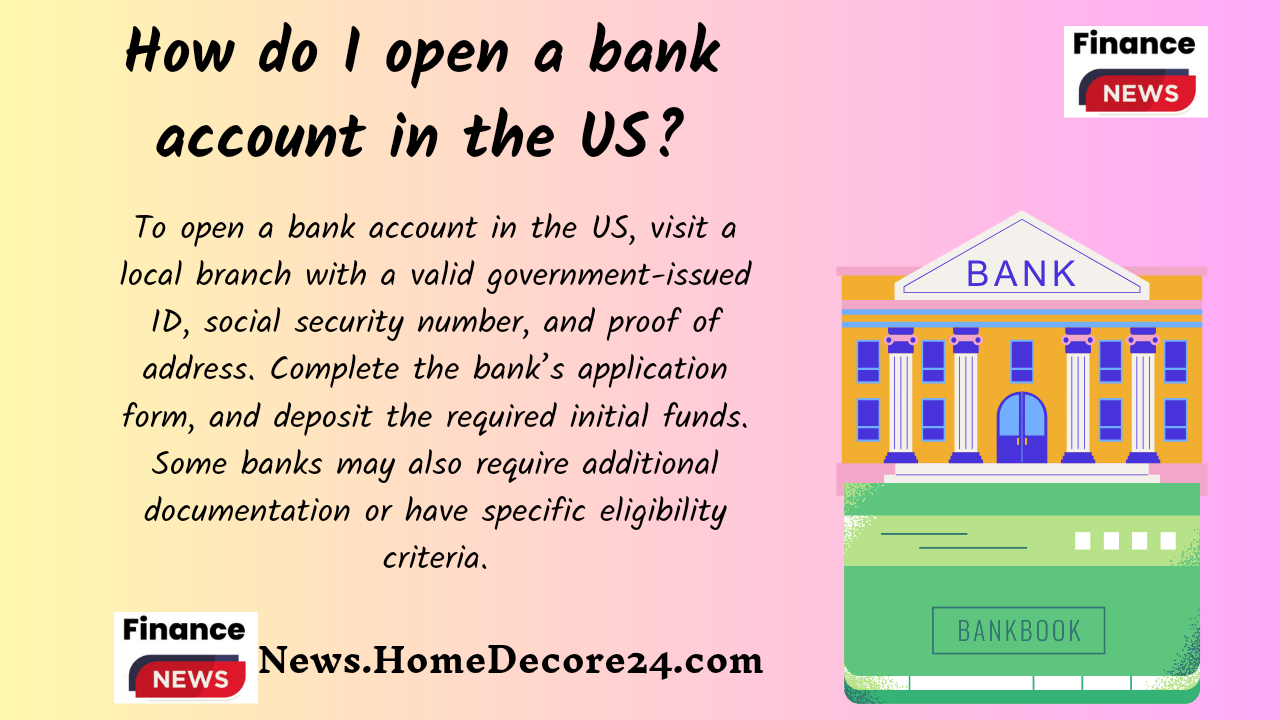
Embarking on the journey of opening a bank account in the United States can be both exciting and essential for managing your finances efficiently. Whether you’re a newcomer to the country, a student, or a resident looking to establish a robust financial foundation, understanding the process is crucial.
In this comprehensive guide, we’ll address eight key questions to demystify the intricacies of opening a bank account in the U.S. From choosing the right type of account to gathering necessary documentation, we’ve got you covered. Let’s dive into the essential steps that will empower you to confidently navigate the U.S. banking landscape.
To open a bank account in the US, visit a local branch with a valid government-issued ID, social security number, and proof of address. Complete the bank’s application form, and deposit the required initial funds. Some banks may also require additional documentation or have specific eligibility criteria.
Read More: Is Student Loan Worth it?(8 Questions Answered!)
Opening a bank account in the US:
Essential steps:
- Gather documents:
- Identification: Two forms of government-issued ID (passport, driver’s license, state ID).
- Proof of address: Utility bill, rental agreement, official document with address.
- Social Security number or Individual Taxpayer Identification Number (ITIN): SSN required for citizens/residents, ITIN for non-residents.
- Opening deposit: Varies by bank, typically $25-$100.
- Choose a bank account type:
- Checking account: Everyday transactions, debit card access.
- Savings account: Earn interest, limited transactions.
- Money market account: Combines features of checking and savings.
- Apply online or at a branch:
- Online: Faster, but requires documentation scans.
- Branch: Personal assistance, immediate account access.
- Fund your account:
- Cash deposit at branch.
- Transfer from another account.
- Direct deposit set up.
Important topics:
- Citizenship status: Different requirements for residents and non-residents.
- Fees: Monthly maintenance fees, overdraft fees, ATM fees.
- Features: Online banking, mobile banking, debit card, checks.
- Minimum balance requirements: Some accounts require maintaining a minimum balance.
- Interest rates: Savings and money market accounts earn interest, compare rates.
How long does it take to open a bank account in the US?
The time it takes to open a bank account in the US can vary, but generally:
- Online: Minutes to a few days. Filling out the application may take 10-15 minutes, and approval and account activation could take 1-2 days.
- In-person: 30 minutes to an hour or more. Filling out paperwork and verifying documents can take longer, but some banks offer instant-issue debit cards, making it faster.
Receiving a physical debit card usually takes 5-7 business days if mailed, but some banks offer expedited shipping or instant issuance.
Read More: What’s The Role of a Stockbroker in Trading?: A Comprehensive Guide
Which bank offer online applications for opening an account?
Here are some major banks in the US that offer online applications for opening an account:
- Bank of America
- Chase Bank
- Citibank
- Wells Fargo
- PNC Bank
- TD Bank
- Capital One
- US Bank
- BB&T
- SunTrust Bank
Please note that this is not an exhaustive list, and there are many other banks and credit unions that offer online account opening. It’s important to compare features and fees before choosing a bank.
What is the minimum balance required to open a bank account?
The minimum balance required to open a bank account in the US varies widely and depends on several factors:
- Bank: Different banks have their own minimum balance requirements, ranging from no minimum to several hundred dollars.
- Account type: Checking accounts often have higher minimums than savings accounts. Money market accounts might have higher minimums still.
- Branch location: Some banks have different minimums for accounts opened at different branches.
Therefore, providing a single answer to your question is impossible.
However, I can offer some general guidelines:
- National banks: Many major national banks like Bank of America, Chase, and Citibank often have minimums between $25 and $500.
- Online banks: Many online banks tend to have no minimum balance requirements.
- Local banks and credit unions: Minimums can vary greatly, so it’s best to check directly with the specific institution you’re interested in.
Important tip: Always research the minimum balance requirements and associated fees before opening any bank account. You can find this information on the bank’s website, or by contacting them directly.
How do I choose the right bank for me?
Prioritize your needs! Consider fees, convenience (online/branch), account features (checking/saving), interest rates, and customer service reviews. Compare options and pick the bank that best fits your lifestyle and financial goals.
Can I open an account if I have bad credit?
Having bad credit might make it trickier, but it’s not impossible! Many banks offer “second chance” accounts or no-credit-check options. Explore credit unions and online banks for more possibilities. Good luck!
Read More: Is stock Market easy to learn?
CEMA Loans: A Comprehensive Guide
How do I avoid overdraft fees?
Overdraft fees can bite! Here are 5 tips to avoid them:
- Track your balance: Regularly check your account online or with a budgeting app.
- Set up alerts: Get notified when your balance dips below a certain amount.
- Opt-out of overdraft coverage: This lets declined transactions prevent fees, but you’ll be responsible for covering any negative balance.
- Link backup accounts: Connect a savings account or line of credit to automatically cover small overdrafts.
- Use cash or a debit card: Avoid swiping your credit card for everyday purchases.
Transfer money from USA to India savings account
Several options exist for transferring money from USA to an Indian savings account:
Online Money Transfer Services:
- Wise (formerly TransferWise): Popular for competitive exchange rates and low fees.
- Remitly: Fast and convenient with options for various transfer speeds and fees.
- Xoom: Offers mobile app transfers and cash pickup options in India.
- Western Union: Well-established brand with numerous agent locations for cash pickup in India.
Bank Transfers:
- Wire transfer: Quickest option but often comes with higher fees. Contact your US bank for details and recipient bank information in India.
- Online banking: Some US banks offer international transfers through their online platforms. Check with your bank for availability.
Other Options:
- Money orders: Less convenient but secure and affordable for smaller amounts.
- Checks: May take longer and incur fees, but a viable option for trusted recipients.
Choosing the best option depends on:
- Transfer amount: Larger amounts might justify higher fees for faster options.
- Urgency: Need the money soon? Choose a faster option like a wire transfer.
- Fees: Compare fees and exchange rates offered by different providers.
- Convenience: Consider online, mobile, or in-person options based on your preference.
Additional tips
- Confirm recipient details: Ensure account name, number, and bank branch information are accurate.
- Compare exchange rates: Get the best value for your money by comparing rates offered by different providers.
- Be aware of hidden fees: Look beyond advertised rates and check for any additional fees before initiating the transfer.
YouTube Video
>Is wells fargo a good bank to bank with?
>Is crypto good investment: A Comprehensive Guide











